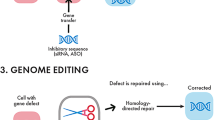Abstract
Numerous studies of the underlying causes of ageing have been attempted by examining diseases associated with premature ageing, such as Werner's syndrome and Hutchinson–Gilford progeria syndrome (HGPS). HGPS is a rare genetic disorder resulting in phenotypes suggestive of accelerated ageing, including shortened stature, craniofacial disproportion, very thin skin, alopecia and osteoporosis, with death in the early teens predominantly due to atherosclerosis1. However, recent reports suggest that developmental abnormalities may also be important in HGPS1,2. Here we describe the derivation of mice carrying an autosomal recessive mutation in the lamin A gene (Lmna) encoding A-type lamins, major components of the nuclear lamina3. Homozygous mice display defects consistent with HGPS, including a marked reduction in growth rate and death by 4 weeks of age. Pathologies in bone, muscle and skin are also consistent with progeria. The Lmna mutation resulted in nuclear morphology defects and decreased lifespan of homozygous fibroblasts, suggesting premature cell death. Here we present a mouse model for progeria that may elucidate mechanisms of ageing and development in certain tissue types, especially those developing from the mesenchymal cell lineage.



Similar content being viewed by others
References
Uitto, J. Searching for clues to premature aging. Trends Endocrinol. Metab. 13, 140–141 (2002)
de Paula Rodriguez, G. H. et al. Severe bone changes in a case of Hutchinson-Gilford syndrome. Ann. Genet. 45, 151–155 (2002)
Burke, B. & Stewart, C. L. Life at the edge: the nuclear envelope and human disease. Nature Rev. Mol. Cell Biol. 3, 575–585 (2002)
Roeber, R.-A., Sauter, H., Weber, K. & Osborn, M. Cells of the cellular immune and hemopoietic system of the mouse lack lamins A/C: distinction versus other somatic cells. J. Cell Sci. 95, 587–598 (1990)
Hutchison, C. Lamins: building blocks or regulators of gene expression? Nature Rev. Mol. Cell Biol. 3, 848–858 (2002)
Spann, T. P., Goldman, A. E., Wang, C., Huang, S. & Goldman, R. D. Alteration of nuclear lamin organization inhibits RNA polymerase II-dependent transcription. J. Cell Biol. 156, 603–608 (2002)
Ozaki, T. et al. Complex formation between lamin A and the retinoblastoma gene product: identification of the domain on lamin A required for its interaction. Oncogene 9, 2649–2653 (1994)
Holaska, J. M., Lee, K. K., Kowalski, A. K. & Wilson, K. L. Transcriptional repressor Germ Cell-less (GCL) and Barrier to Autointegration Factor (BAF) compete for binding to Emerin in vitro. J. Biol. Chem. 278, 6969–6975 (2003)
Worman, H. J. & Courvalin, J. C. The nuclear lamina and inherited disease. Trends Cell Biol. 12, 591–598 (2002)
Hoeffel, J. C., Mainard, L., Chastagner, P. & Hoeffel, C. C. Mandibulo-acral dysplasia. Skeletal Radiol. 29, 668–671 (2000)
Bonne, G. et al. Mutations in the gene encoding lamin A/C cause autosomal dominant Emery-Dreifuss muscular dystrophy. Nature Genet. 21, 285–288 (1999)
Ackerman, J. & Gilbert-Barness, E. Hutchinson-Gilford progeria syndrome: a pathologic study. Pediatr. Pathol. Mol. Med. 21, 1–13 (2002)
Sarkar, P. K. & Shinton, R. A. Hutchinson-Guilford progeria syndrome. Postgrad. Med. J. 77, 312–317 (2001)
Sullivan, T. et al. Loss of A-type lamin expression compromises nuclear envelope integrity leading to muscular dystrophy. J. Cell Biol. 147, 913–920 (1999)
Lewis, M. PRELP, collagen, and a theory of Hutchinson-Gilford progeria. Ageing Res. Rev. 2, 95–105 (2003)
Vigouroux, C. et al. Nuclear envelope disorganization in fibroblasts from lipodystrophic patients with heterozygous R482Q/W mutations in the lamin A/C gene. J. Cell Sci. 114, 4459–4468 (2001)
Morris, G. E. The role of the nuclear envelope in Emery-Dreifuss muscular dystrophy. Trends Mol. Med. 7, 572–577 (2001)
Raharjo, W. H., Enarson, P., Sullivan, T., Stewart, C. L. & Burke, B. Nuclear envelope defects associated with LMNA mutations cause dilated cardiomyopathy and Emery-Dreifuss muscular dystrophy. J. Cell Sci. 114, 4447–4457 (2001)
Todaro, G. J. & Green, H. Quantitative studies of the growth of mouse embryo cells in culture and their development into established lines. J. Cell Biol. 17, 299–313 (1963)
Taylor-Jones, J. M. et al. Activation of an adipogenic program in adult myoblasts with age. Mech. Ageing Dev. 123, 649–661 (2002)
Kirkland, J. L., Tchkonia, T., Pirtskhalava, T., Han, J. & Karagiannides, I. Adipogenesis and aging: does aging make fat go MAD? Exp. Gerontol. 37, 757–767 (2002)
Stewart, C. L. Production of chimeras between embryonic stem cells and embryos. Methods Enzymol. 225, 823–855 (1993)
Upchurch, D. A., Shankarappa, R. & Mullins, J. I. Position and degree of mismatches and the mobility of DNA heteroduplexes. Nucleic Acids Res. 28, E69 (2000)
Lewandoski, M., Meyers, E. N. & Martin, G. R. Analysis of Fgf8 gene function in vertebrate development. Cold Spring Harb. Quant. Biol. 62, 159–168 (1997)
Lufkin, T. et al. Homeotic transformation of the occipital bones of the skull by ectopic expression of a homeobox gene. Nature 359, 835–841 (1992)
Sabourin, L. A. et al. Reduced differentiation potential of primary MyoD-/- myogenic cells derived from adult skeletal muscle. J. Cell Biol. 144, 631–643 (1999)
Acknowledgements
We thank L. Sewell for technical assistance in our animal facility; D. Haines and D. Smith for help in pathological examination of the mice; H. Wimbrow for assistance in the use of the Piximus densitometer; R. Frederickson for preparation of the figures and B. Burke and B. Howard for discussions.
Author information
Authors and Affiliations
Corresponding author
Ethics declarations
Competing interests
The authors declare that they have no competing financial interests.
Rights and permissions
About this article
Cite this article
Mounkes, L., Kozlov, S., Hernandez, L. et al. A progeroid syndrome in mice is caused by defects in A-type lamins. Nature 423, 298–301 (2003). https://doi.org/10.1038/nature01631
Received:
Accepted:
Issue Date:
DOI: https://doi.org/10.1038/nature01631
- Springer Nature Limited
This article is cited by
-
Scaling behaviour and control of nuclear wrinkling
Nature Physics (2023)
-
Mitochondrial phosphatase PGAM5 modulates cellular senescence by regulating mitochondrial dynamics
Nature Communications (2020)
-
The role of lamin A/C in mesenchymal stem cell differentiation
Journal of Physiology and Biochemistry (2019)
-
Forced expression of mouse progerin attenuates the osteoblast differentiation interrupting β-catenin signal pathway in vitro
Cell and Tissue Research (2019)
-
Lamin A/C Cardiomyopathy: Implications for Treatment
Current Cardiology Reports (2019)





